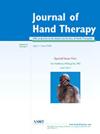Acceptability and safety of 3D printed wrist-based orthoses compared to fiberglass casts for the treatment of non-surgical distal radius- and scaphoid fractures: A randomized feasibility trial
IF 2.1
4区 医学
Q2 ORTHOPEDICS
引用次数: 0
Abstract
Background
Non-invasiveness and comfort are crucial in the conservative management of distal radius and scaphoid fractures. While fiberglass casts are standard, three-dimensional (3D)-printed orthoses offer a promising alternative.
Purpose
To compare patient experiences, safety perceptions, and satisfaction between a 3D orthosis and fiberglass cast for distal radius or scaphoid fractures.
Study Design
Randomized feasibility trial.
Methods
Nineteen adult patients were randomly assigned (3D orthosis group, n = 10; fiberglass cast group, n = 9) and followed until orthosis or cast removal at 6–8 weeks. X-rays at weeks 1 and 6 documented bone healing, with weekly hand therapy visits assessed orthosis satisfaction and function. The Patient-Rated orthosis Satisfaction Questionnaire (PRSEQ) measured satisfaction at weeks 2, 4, and removal. Descriptive statistics and non-parametric correlation tests were used for data analysis.
Results
The 3D orthosis group achieved significantly higher PRSEQ scores (mean difference [MD] = 15.7%, p = 0.005 to 0.01, r = −.581 to −.638) and lower perceived pain (MD = −1.0 to −2.2, p = 0.001 to 0.048, r = −0.45 to −0.75) compared to the cast group. By week 4, the 3D group reported less discomfort (MD = −2.2, p = 0.03, r = −0.5) and felt safer (MD = 1.6, p = 0.043, r = −0.46). Routine activities were easier for the 3D group at weeks 2 and 6 (MD = −2.8 to −3.0, p = 0.033 to 0.034, r = −0.49). Satisfaction scores were higher in the 3D group (mean 8.4 vs. 5.6 points, p < 0.001 to 0.01, r = −0.57 to −0.82). Compliance was excellent in both groups. No significant differences were observed in radiological outcomes, finger sensibility, or edema. Bone healing occurred in both groups without fracture displacement; however, one cast patient required subsequent surgery for scaphoid non-union.
Conclusions
Treatment with a 3D-printed orthosis appeared feasible and safe, with patients reporting higher satisfaction and better self-perceived hand function compared to a custom-made fiberglass cast, although further research is needed to confirm these findings.
与玻璃纤维模型相比,3D打印腕部矫形器用于治疗桡骨远端和舟状骨骨折的可接受性和安全性:一项随机可行性试验
背景:非侵入性和舒适性对于桡骨远端和舟状骨骨折的保守治疗至关重要。虽然玻璃纤维铸造是标准的,但三维(3D)打印矫形器提供了一个很有前途的选择。目的:比较3D矫形器和玻璃纤维铸造治疗桡骨远端或舟状骨骨折的患者体验、安全性认知和满意度。研究设计:随机可行性试验。方法:随机选取19例成人患者(3D矫形器组,n = 10;玻璃钢铸造组(n = 9),随访至6-8周矫形或拆除铸造。第1周和第6周的x光片记录了骨愈合,每周进行手部治疗,评估矫形器的满意度和功能。患者评价矫形器满意度问卷(PRSEQ)在第2周、第4周和拔除时测量满意度。采用描述性统计和非参数相关检验进行数据分析。结果:3D矫形器组PRSEQ评分明显高于对照组(平均差异[MD]= 15.7%, p = 0.005 ~ 0.01, r = -)。581至- 0.638)和较低的感知疼痛(MD=-1.0至-2.2,p = 0.001至0.048,r = -0.45至-0.75)。到第4周,3D组报告的不适较少(MD=-2.2, p = 0.03, r = -0.5),感觉更安全(MD=1.6, p = 0.043, r = -0.46)。3D组在第2周和第6周的常规活动更容易(MD=-2.8至-3.0,p = 0.033至0.034,r = -0.49)。3D组的满意度得分更高(平均8.4分对5.6分,p)。结论:使用3D打印矫形器治疗似乎是可行和安全的,与定制的玻璃纤维铸造相比,患者报告更高的满意度和更好的自我感知手部功能,尽管需要进一步的研究来证实这些发现。
本文章由计算机程序翻译,如有差异,请以英文原文为准。
求助全文
约1分钟内获得全文
求助全文
来源期刊

Journal of Hand Therapy
医学-外科
CiteScore
3.50
自引率
10.00%
发文量
65
审稿时长
19.2 weeks
期刊介绍:
The Journal of Hand Therapy is designed for hand therapists, occupational and physical therapists, and other hand specialists involved in the rehabilitation of disabling hand problems. The Journal functions as a source of education and information by publishing scientific and clinical articles. Regular features include original reports, clinical reviews, case studies, editorials, and book reviews.
 求助内容:
求助内容: 应助结果提醒方式:
应助结果提醒方式:


